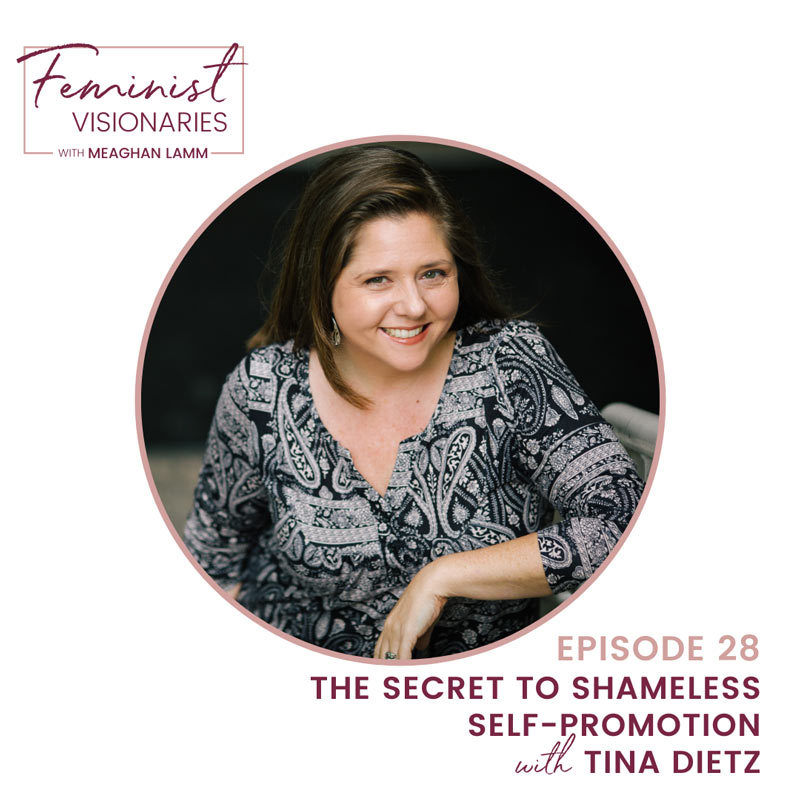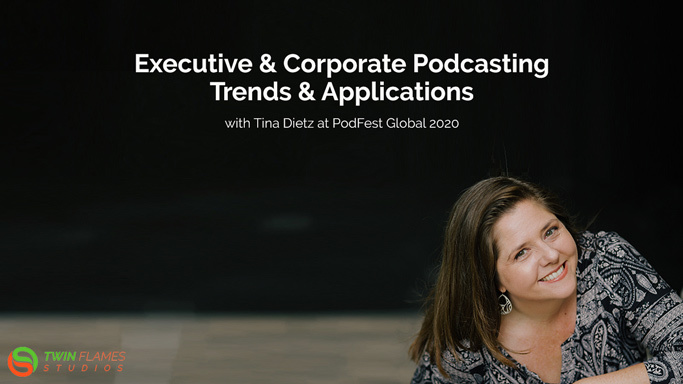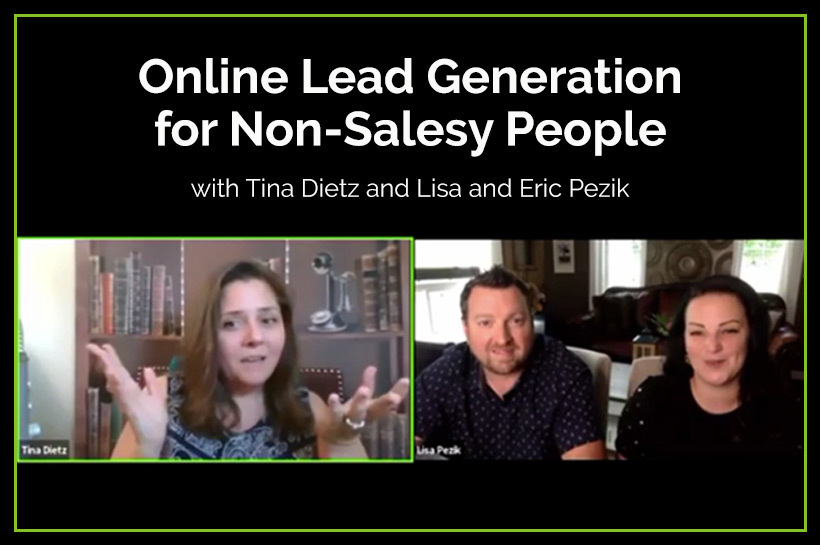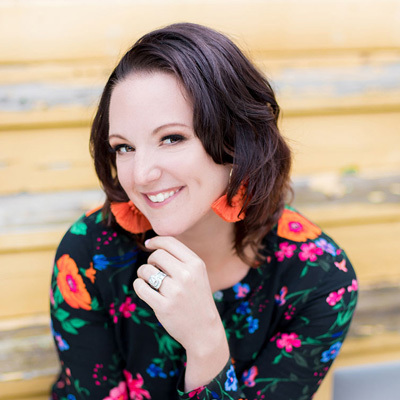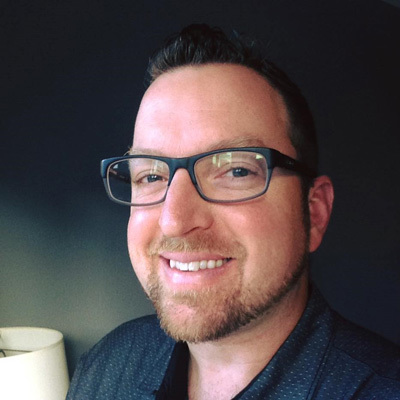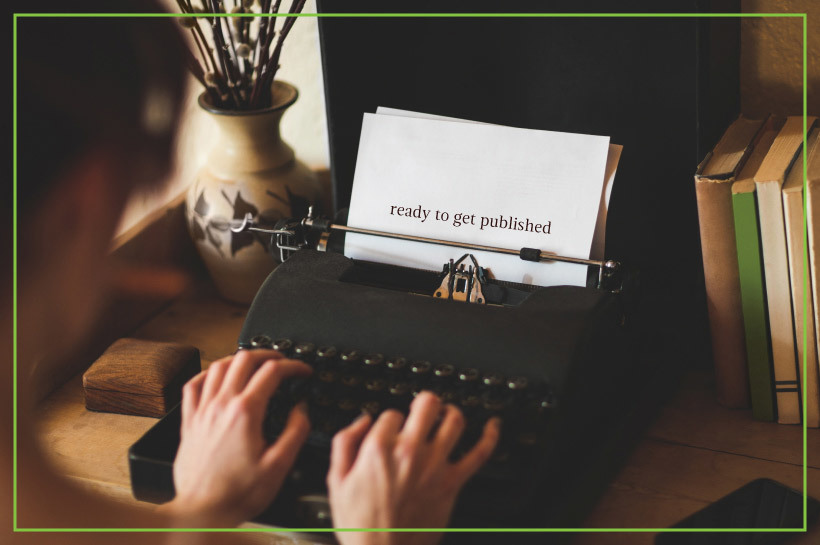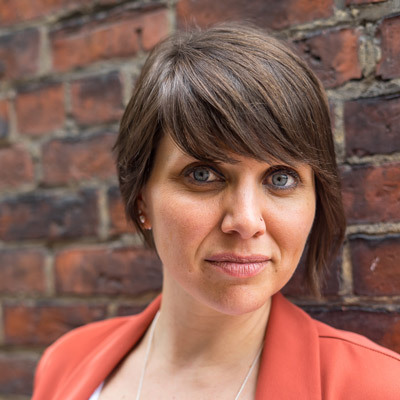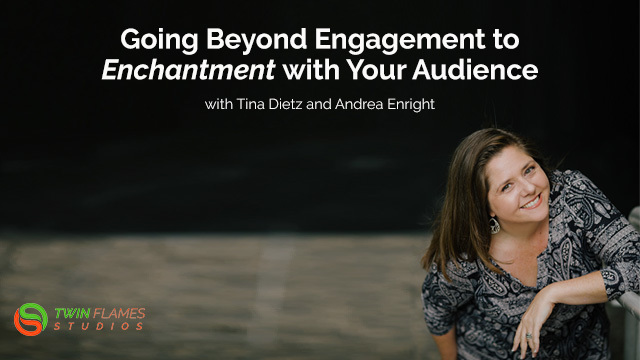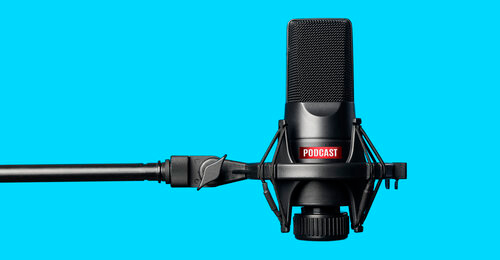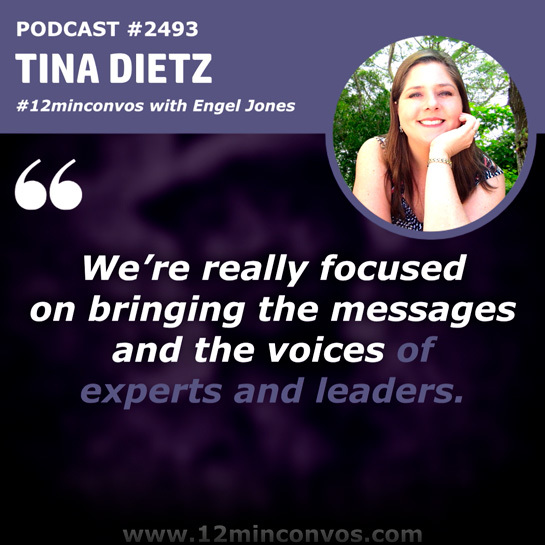The Secret to Shameless Self-Promotion with Tina Dietz [Podcast]
If you struggle with shameless self-promotion, listen to my guest appearance on the new episode of the Feminist Visionaries Podcast, hosted by Meaghan Lamm.(Feminist Visionaries Podcast with Meaghan Lamm, January 2021)
Tina talks with Meaghan Lamm about how we can feel our feelings, get curious about our thoughts, and shamelessly self-promote.
In this episode:
- The number one block preventing people from shamelessly promoting themselves
- Tina’s top tips on how to use your fear to propel you instead of hold you back
- Mindset techniques to shamelessly self-promote yourself and your business
—
Listen to the podcast here:
The Secret To Shameless Self-Promotion with Tina Dietz
I’m super excited to have you here. I’ve wanted to have you on the podcast for many months and I’m excited to talk about shameless self-promotion. I think this is the topic that a lot of women in particular struggle with or even self-promotion in general.
Before we dive into that, tell us who you are and what you do on the internet.
I own a company called Twin Flames Studios, and after many years of building businesses internationally in more than 20 different industries, I now specialize in the world of audio to help people get their messages out into the world. We produce and develop podcasts. We work with thought leaders and subject matter experts to get their audio books produced and out into the world, as well. On a personal level, I work with folks on vocal leadership, which is a whole other body of work.
Your team produced about the first two-dozen episodes of this podcast. I don’t think this podcast would exist without you. If I hadn’t hired you for the added accountability, I don’t know that this podcast would have happened.I remember in the very beginning, you sent me some really great exercises and articles to improve my vocal leadership. There were so many things I learned, like how the inflection in your voice can convey a certain emotion, whether you’re intending to do it that way or not, which I found fascinating.
Yes, we had that whole conversation about uptalk where we subconsciously raise the inflection of our voice at the end of our sentences like it’s a question when we mean to make it a statement. And then that makes us sound like we don’t know what the hell we’re talking about.
It also points out things within yourself that you didn’t realize were there because it’s a very subconscious thing. You’re not consciously ending all of your statements as a question because you lack confidence in that area. It’s very subconscious. Once I realized I was doing it, it was interesting to note which moments it popped up in my speech. Then I started to work on that with my mindset coach.
That’s perfect.
When you’re working with your vocal leadership clients and you get into the issue of shameless self-promotion, what would you say is the number one block that people have when it comes to promoting themselves shamelessly?
I would say the number one thing is that people don’t want to piss anyone off with what they’re saying. They don’t want to upset anyone. Not a single one of us enjoys looking stupid or being embarrassed. That’s the shame part and that’s why Brené Brown says shame is a master emotion. Shame is really what’s underneath. I don’t want people to be mad at me. I don’t want to upset anyone. I don’t want to rock the boat. I don’t want to look bad. I don’t want to be embarrassed. All of those and more. It really comes down to that being the core of what stops us from stepping out and speaking our truth.
Absolutely. To get to the point of starting this podcast, it was a big vulnerability moment for me. I had to put myself out there, knowing how feminists and women with strong opinions are often treated on the internet. Creating this podcast and putting it out into the world, with my opinions, was a big vulnerability moment for me.
I haven’t run into many haters yet, but there was a lot of mental work that went into gearing up for this shameless self-promotion, as we’re calling it, because I knew that even though as many supporters as I have, there is also a flip side to that. The people who troll you, especially in today’s political climate, where it gets nasty on the internet.
What are your top tips on sitting with that vulnerability and fear, the fear of looking stupid or like you don’t know what the hell you’re talking about? What are your tips on sitting with those emotions and letting them propel you rather than stop you?
Most of us have a tendency to delay the intensity of what we feel. We’re trained to control our emotions and put a clamp on them. What we’re not trained to do is to allow ourselves to have the capacity to be with strong emotions and let them move through us. That is a learned practice.
It is an emotional, psychological, energetic practice of allowing yourself to feel whatever it is that you’re feeling. When you’re first starting to do this, you’re going to notice all the thoughts attached to it. The questions, decisions, and things that you say about yourself and the world. And it’s not pretty. You have to learn to become an observer of your own thought and not dissociate yourself.
Start to gain some objectivity where you observe the feelings or thoughts that you’re having like a movie. If you can identify it, you can start to move things in different directions. If you feel like you’re at a point where you just can’t move past it or something that is unsayable or unendurable, start to identify the component parts of that feeling. Identify the physical sensation, the things that you say to yourself, the things that you say about the world, and so on. Break that down into its component parts and you start to be able to make choices. And choices give you power.
‘Choices’ was my word of the year for 2020. This year, I had to make a lot of choices and to feel my feelings rather than numb them out so that I could get to a place where I could do things while feeling fear. Fear is typically at the core of everything we’re avoiding doing. If you sit with it long enough, you’re going to realize there’s an underlying fear for not wanting to do whatever you’re avoiding.
So you have to sit with it. It doesn’t go away. It is a conditioned, biological response to keep you safe. Fear used to keep you safe from saber-toothed tigers, and now it keeps you safe from stress or bad chicken.
And trolls on the internet.
And trolls on the internet. The fear doesn’t go away. You just learn how to acknowledge the fear and do the scary thing anyway. I think that’s the place that you have to get to for authentic, shameless self-promotion. To authentically and shamelessly do what you have decided is your mission here on this earth in this lifetime, you have to get to a point where you’re not numbing out the emotions that are uncomfortable.
You’re feeling them and you’re acknowledging them. You’re not telling yourself you’re wrong for feeling them because you’re a human being and you experience the whole range of human emotions. Then, you go out and do the thing anyway.
When I first started my journey through mindset work in 2016, I had never heard the phrase before. No one asked me, how does that make you feel? How does this frustrating situation make you feel? My family did not talk about uncomfortable things. If we had uncomfortable things going on, we handled it very poorly on our own and when we came back together, we pretended like nothing happened.
As a result, I can’t say I grew up to be a super well-adjusted human being who is able to freely express her emotions. But working through that has most definitely been a journey for me, because I had to learn, often painfully, how to stop numbing my feelings by overworking. It’s really common in hustle culture to numb oneself by scrolling on social media or binging on Netflix.
Instead of asking you if you’re still watching, Netflix should have an emotional setting that asks if you are numbing your feelings or actually watching something.
Yes, exactly! I had such a difficult time recognizing when I was feeling anything, because I had numbed it for so long that I just had to name the physical sensations that were happening in my body.
That was how I found out that being mad makes my fingers tingle. It was so fascinating to me to learn how to do that. For a long time, I felt really dumb because I was 30 and I didn’t know what my feelings felt like. I think that happens to a lot of people and I’m hoping that this episode really normalizes that because a lot of us are not taught how to process our emotions. Human beings are designed not to be uncomfortable.
Absolutely. When I’m working with executives and we’re talking about vocal leadership and communication, we talk about how your internal landscape changes your external landscape. If your physical voice is the instrument that you’re playing, like an oboe or violin, then your internal conversation, beliefs, feelings and the things that you say are the music that you’re playing. You’ve written that music. In order to become a virtuoso and be able to play the music that you want to play with your voice and your message, you have to look at the music that you’re playing.
Where are you missing a verse or skipping over things? Where is the tempo off? The voice is such a great indicator of our internal music where we might have a stanza or two that are not in sync with the rest of the composition. One of the quick exercises we can do around embodiment is to bring up all of the physical sensations of what it feels like to be the best version of yourself. We can use this to train our bodies to actually feel better when we are experiencing things that we don’t love feeling. We can do it on the other side as well and train ourselves to feel the way we want to feel because neurologically, the brain doesn’t know the difference between fantasy and reality. It’s a programming issue.
Brains are fascinating. This is why people get sucked into cults.
Absolutely. Politics, as well. If you bring up a peak experience, where you felt like a great version of yourself and allow yourself to go into that memory, you can change your body chemistry. Bring up that experience in your body, as if it’s happening in the moment. Scan your body, scan your thoughts, scan your feelings, and you can change your body chemistry in under two minutes.
You can practice feeling better and like the best version of yourself. We spend a lot of time analyzing what we consider negative emotions. We spend time processing when you’re angry or sad or feeling hopeless, but it works on the opposite side of things, too. A lot of times, we leave the other emotions out of the equation, because happiness feels like something that happens to us and not something that comes from us. Confidence is another one. No one’s ever told us you can feel confident because you choose to feel confident.
It’s true. I have people tell me all the time that I’m so confident and that they are intimidated by me. I’m always looking over my shoulder wondering who they’re talking to because those aren’t the thoughts that are on a loop in my brain. When other people can mirror back what I’m actually projecting out into the world, which isn’t necessarily a facade, is really interesting. I’m not thinking of myself that way, but that’s certainly how I’m coming across because that’s how I’m acting. Which is a weird dichotomy when you think about it.
I think that has come from doing the work and feeling the feelings and identifying what’s going on and being able to work through it without making myself feel bad. When you try to numb the negative feelings, you also numb the positive feeling.
Yeah, the whole thing gets deadened.
It all comes from the same place so you can’t numb one without numbing the other. You have to allow yourself to experience the entire range of human emotion in order to experience authenticity and just as a human being in general.
Have you seen the movie Finding Nemo?
Yes, I’m pretty sure I just watched it a couple weeks ago.
That’s hysterical. I love that movie. One of my favorite parts is the sharks that are trying to not kill other fish. They have this whole kind of 12-step group and their motto is ‘fish are friends, not food’. I’ve changed that to ‘feelings are friends, not foes’. Think about how you can be friendly and have room for all of your emotions.
One of my favorite books is Big Magic by Elizabeth Gilbert. She talks about fear being ever present in a creative life. What is important is how you deal with that fear. It’s how you make space for it and that is a really powerful concept. It takes a tremendous amount of energy and will and that’s unnecessary to kind of squish that into a box. You can leave room for fear in the backseat of your car, like she talks about. Fear does not get to touch the radio, fear does not get to choose where you’re going. It doesn’t get to have an opinion on where you stop for snacks, but there’s room for it in the backseat.
I love that analogy. I imagine shoving my fear into the backseat and telling it to sit down and shut up. I call my fear Karen, who lives inside my brain and is very negative. I get to the point where I say Karen, thank you for your opinion, you can sit down now. I can picture her stomping away in her high heels with her Karen haircut and sitting down in the back of the room.
This is very effective for me. I think this conversation is so relevant to feminism and feminism ideas of toppling the patriarchy. This is for men, women, and non-gender conforming people. Men are embroiled in toxic masculinity, where feeling any other emotion besides anger is seen as a weakness. Women are constantly told that they’re too emotional. Opposite ends of the spectrum: women have too many emotions and men don’t have enough. We can get to a place where every emotion is valid and it’s safe to experience and express every emotion.
Not just safe within yourself, but safe to have emotions externally around other human beings. When we can get to a point where we don’t need toxic masculinity anymore, because it doesn’t matter if a man cries, he can feel more feelings than anger. He can express more feelings than anger without somebody calling his masculinity into question.
It is a tool to break out of this patriarchal society if we can get to a place where women aren’t trying to appear less emotional and men are not embroiled in anger as the only good emotion to have.
We’re all highly emotional beings. It’s a matter of expression and what we feel safe expressing in a situation. This ties into this idea of shameless self-promotion because we’re always in self-promotion. We’re always promoting something. It could be something that you have an opinion about. As a human being walking around, can you state your opinion, and be okay with that? Can you have a conflict at work and work through that in a way that feels both productive and stimulating?
It does bring up strong emotions, but you work through it together rather than shutting it down. One of the biggest access points for mustering that kind of mastery of emotions is curiosity. Curiosity is my favorite state of being because curiosity is neutral. It is neither good nor bad. If you’re upset, you might not be able to feel good but you might be able to access curiosity. I wonder how I can just feel a little bit better right now. It snowballs its way out of something. It’s not an all at once process and it is a never ending process.
You get through one plateau and you think that x is your problem. So you work your way through x and you grow from that work. Then you move along and find another problem that you have to work through. This is especially true in business where you think that your next goal is to make $5,000 a month and when you get there, there’s a whole new set of mindset work to be done. And so on and so forth.
You’re not fixing your issues. You don’t fix them one time and then never have them again. As you evolve and grow, whatever your goals are, whether it’s money or relationships or whatever, there’s always going to be something else that you’re running into. Your brain is constantly trying to keep you safe from what it perceives as dangerous threats and your brain thinks that anything that it doesn’t know the outcome of is a dangerous threat. If your brain can’t predict exactly what’s going to happen, it thinks you’re in danger. It’s going to try to get you not to do that and the most effective way to get you not to do that is to make you afraid.
No matter what you’re doing, no matter where you’re going, you have to remember, you’re always going to be afraid and you just have to remind your brain that it’s okay to be afraid, but you’re going to do it anyway. Putting yourself out there is probably not going to kill you.
No, absolutely not. You mentioned your inner Karen before. When we’re dealing with fear, one of the visuals that I like to use is a puppy or a kitten because our fear isn’t evolved. Our fear isn’t us. If you imagine that your fear is a puppy or a kitten that is scared and needs to be taken care of, if that appeals to you more, then you can bring up the self-compassion to take care of that.
Assert yourself as the adult taking care of that piece of yourself rather than it being an overwhelming, all-consuming thing or becoming enraged at yourself, which God knows I’ve done many times in the past. Asking myself why do I feel this way? Why do I suck? I love the idea of being able to just sit with those emotions.
As a side note on the business side of things, when we’re talking about self-promotion, it’s a big hurdle for a lot of people. Particularly artists and people who are more on the ‘woowoo’ side of things, which I would classify myself on that side of things. For an analogy, if you offer someone a homemade cookie and whether they accept your cookie or not, it has nothing to do with your cookies. A person may say no because they don’t want a cookie, or they don’t like chocolate, or maybe they’re diabetic. They have their own reasons for saying no and nothing is wrong with your cookie. The same is true for them saying yes. There’s nothing wrong with you when somebody says yes or no to what you’re putting out into the world.
That is a big hurdle for anybody to get over when they’re first starting a business or even as their business grows. Especially when you’re an entrepreneur and you’re in business for yourself. Many businesses are a personal brand using the owner’s name. You’re not selling a product, you are selling yourself.
I have a friend who owns a bookstore and when people don’t buy a book, she gets annoyed. She gets annoyed when they come in and wander around the shop, admire her store, but don’t buy anything. But she doesn’t take that personally, because she’s selling a product. She’s selling books.
When you’re selling your service, your knowledge, your expertise, your strategy, you’re selling yourself on a very personal level. It can be difficult to remember that you’re not really selling yourself, but that you’re selling them an outcome. Those two things do not have to be related. If someone says no, it’s because they weren’t interested in what you had to buy, just like they weren’t interested in your cookie, and that leaves more for the people who are interested.
I think that’s a fantastic way of looking at it. It’s never about us. It’s always about the other person and what they’re experiencing. If we make it about ourselves, we’re not going to sell anything. Coming from personal services, it all has to be about what the outcome is. We’re all self-centered. Human beings are wired to be self-centered. When you’re talking with other people or you are marketing on social media, being curious and interested in what other people are up to is always going to be the pathway to building your business. Particularly in personal services, because relationships are at the heart of every single thing.
Long story short, you can fix the entire world by feeling your feelings and changing your thoughts. Your ego just solved it all. This conversation didn’t go how I was anticipating it to go honestly, but I loved where we ended up because we kind of dived more into authenticity.
In order for you to be the most authentic version of yourself, you have to acknowledge that you are a whole person with the entire range of human emotion inside of you. It is okay and normal and good for you to feel all of your feelings. To acknowledge them. Sometimes I am in a shitty mood for no reason and that is okay.
It’s okay to be pissed off for no reason and take the day to not do anything or not communicate with people because you keep snapping at them. That’s normal. I think that in order for you to get to a point of shameless self-promotion, you first have to explore shameless authenticity. Once you do that, you get to a place where you’re feeling your feelings, because you acknowledge that you’re a human being with human emotions and feeling your feelings can help you topple the patriarchy.
I think that sounds like a perfect place to close, don’t you?
I absolutely do. Feel your feelings, change your thoughts, topple the patriarchy.
Listen to this one over and over again. I’m sure I will be listening to it multiple times because these lessons are so important. These are tools to go in your toolbox that you can use over and over again. When you get curious, don’t be afraid of feeling your feelings. Don’t be afraid of your thoughts or changing your thoughts. Together we’ll all feel our way through toppling the patriarchy and everything will be great.
Thanks for listening to the Feminist Visionaries podcast!
Important Links:
- Twin Flames Studios
- https://www.facebook.com/TwinFlamesStudiosLeadership
- https://www.instagram.com/thetinadietz
- https://www.linkedin.com/in/tinadietz
- Free gift from Tina: https://launchyouraudiobook.com/
Send me a message if you’d love to chat more about what partnering together would look like!

